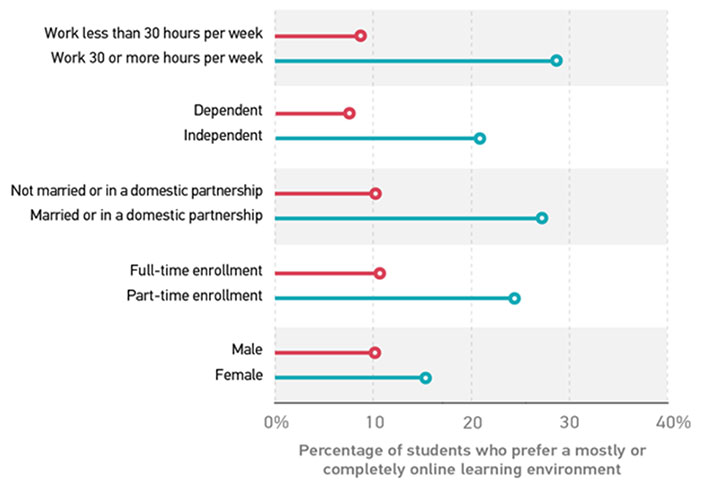Commuter students' demographics are driving their learning environment preferences.

Prior to the COVID-19 pandemic, college campuses were full of students camped out in the libraries and public spaces with their papers spread out, laptops humming, water bottles filled, energy drinks and food on hand, and a cache of quarters ready to feed parking meters or pay for public transportation. These students were likely also fielding text messages from family and checking their schedules to see how much time they had to complete an assigned reading before heading back to work. Or, perhaps they were trying to figure out when they would need to pack up and make the fifteen- to twenty-minute one-way walk to the commuter students' parking lot on campus to feed the parking meter and get to class. These students experience campus life a lot differently than students who live on campus and take a five-minute stroll from their dorm to their classroom (which is right next to the campus coffee shop) with their laptop in hand.
Before the pandemic, nontraditional students expressed their preferences for mostly or completely online learning environments. Their unique life circumstances, which make online components more attractive, may allow them to better adapt to recent shifts away from face-to-face learning. However, these students will certainly also face a unique set of challenges as home life during the COVID-19 crisis continues to evolve. Institutions know that students who study remotely need access to robust Wi-Fi and workhorse devices. As they gradually reopen in a post-pandemic world, the need remains for institutions to also understand the demographic characteristics that influence commuter students' learning environment preferences.
EDUCAUSE found that 72% of students who participated in our annual student and technology study were commuter students.1 But unfortunately, there hasn't been a lot of analysis about what is driving commuter students' learning environment preferences. These students may want to take online or blended courses, which can decrease or eliminate their commute times, increase their time with their families, and provide them with flexible opportunities to balance work and academic responsibilities. But face-to-face learning can also be beneficial for these students. Engaging in face-to-face classes can allow commuter students to nurture relationships with faculty and can create opportunities for students to participate in campus activities and engage with their academic peers, all of which may increase retention and graduation rates.2 Using data from the EDUCAUSE student and information technology survey, we identified which characteristics are driving (pun intended!) commuter students' learning environment preferences.
In 2018,3 65% of commuter students indicated a preference for mostly or completely face-to-face learning environments, compared to 82% of on-campus students. However, 14% percent of commuter students said they preferred mostly or completely online courses, compared to 4% of on-campus students. What could be driving these preferences?

Employment status, dependent status, relationship status, enrollment status, and gender appear to be driving these preferences. Commuter students who said they worked at least thirty hours a week were more than three times as likely to prefer online learning environments as those who worked less than thirty hours per week (figure 1). Independents (with or without dependents), those who are married or have a domestic partner, and those who attend school part time were more than twice as likely to prefer online learning environments as students who are dependents, single, or enrolled full time. Female commuter students were one-and-a-half times as likely to prefer mostly or entirely online learning environments as male commuter students were. Additionally, each of the five characteristics identified above is significantly associated with higher odds of preferring online course components even when combined into a statistical model controlling for each characteristic as well as ethnicity and Pell Grant eligibility.4 This suggests a particular demographic of students that institutions need to pay close attention to. Working, having a partner, and slowly making one's way to degree completion (through part-time enrollment) present a picture of an individual who has a decidedly different experience from the student who lives on campus and is fresh out of high school. Commuter students are already working but are likely seeking a degree to advance their careers.
An important demographic in higher education is gravitating toward online coursework. Commuter students who are independent (with or without dependents), married or in a domestic partnership, female, enrolled part time, and who work at least thirty hours per week are taking advantage of the online learning environment in higher education. This is good news, as online learning has increased access to higher education for many. However, recent reports have indicated that outcomes (such as graduation) are lagging behind access.5 Institutions need to provide clear communication to these students about the expectations, challenges, workload, and anticipated outcomes for mostly or completely online coursework. Although many working commuter students may prefer not to head to the classroom after (or before) work, pay for parking, or "camp out" while waiting for a face-to-face course, doing these things may be a more viable option based on the academic goals of these students. Institutions should be aware that commuter students' demographics are driving their learning preferences. By better understanding these preferences, institutions may be in a better position to guide students to a learning environment that can best facilitate their academic success.
For more information and analysis about higher education IT research and data, please visit the EDUCAUSE Review Data Bytes blog as well as the EDUCAUSE Center for Analysis and Research.
Notes
- Joseph D. Galanek, Dana C. Gierdowski, and D. Christopher Brooks. ECAR Study of Undergraduate Students and Information Technology, 2018. Research report. Louisville, CO: ECAR, October 2018. ↩
- Douglas A. Guiffrida, "Toward a Cultural Advancement of Tinto's Theory," The Review of Higher Education, 29, no. 4 (Summer 2006): 451–472. ↩
- In 2019, fewer students indicated a preference for mostly or completely online courses than in 2018. But generally, commuter students prefer mostly or completely online learning environments more than their on-campus peers. ↩
- Logistic regression estimated odds ratios for these five predictors range from 1.5 to 2.8. ↩
- Doug Lederman, "Online Options Give Adults Access, but Outcomes Lag," Inside Higher Ed, June 20, 2018. ↩
Joseph D. Galanek is a Senior Researcher at EDUCAUSE.
Ben Shulman is a Statistician at EDUCAUSE.
© 2020 Joseph Galanek and Ben Shulman. The text of this work is licensed under a Creative Commons BY-NC-ND 4.0 International License.
